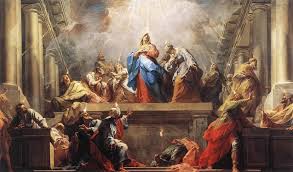The unity between the Holy Spirt and Mary is so intimate that each one can be called the Immaculate Conception—one in eternity, and one in time. However, to understand the importance of Mary in our lives, we have to understand the basics of the Holy Spirit, as given to us by the earliest Christians. This post will be like a tornado hitting a junk pile and then organizing it into nice categories, so bear with the heavy theology at the beginning.
Every earthly analogy to explain the Blessed Trinity eventually breaks down, but the least-failing analogy is the following: The Trinity is like a fire. There is a flame. There is a light. There is heat. In this analogy, the flame is the God the Father (the origin), the light is God the Son (the only one seen by human eyes) and heat is God the Holy Spirit (for obvious reasons.) The flame is not the light. The light is not the heat. The heat is not the flame. But you can not have the flame without the light, nor the light without the heat nor the heat without the flame. The flame is the fire. The light is the fire. The heat is the fire. One fire. So also: One God. Three persons.
St. Augustine had a pretty good analogy, too. He compared the Trinity to the faculties of the human soul. He compared God the Father to the memory, God the Son to the intellect and God the Holy Spirit to the will. Three faculties, but only one center to your responsibility. Furthermore, although the persons of the Blessed Trinity have no need for faith or hope, our faculties do have such a need, and the Church Fathers linked this up, too: Our memory is perfected by hope, our intellect by faith and our will by charity or love. Thus, we have the three supernatural virtues of faith and hope and love as found in 1 Corinthians 13.
If we put all this together, we have this:
God the Father—Flame—Memory—Hope
God the Son—Light—Intellect—Faith
God the Holy Spirit—Heat—Will—Charity
Mary’s relationship to each of the three is important, but (per the title of the article) we’re going to focus on the third category in bold.
Amazingly, you can have supernatural faith without supernatural charity: “If I have all faith, so as to remove mountains, but have not charity, I am nothing.”—1 Cor 13:2b. On the contrary, the only place you can have charity without faith is heaven, since “faith is the substance of things hoped for, the evidence of things not seen.” (Heb 11:1) Why won’t there be faith or hope in heaven? Precisely because faith refers to things not seen and in heaven we will see God face to face. When a person dies in sanctifying grace, his faith and hope terminate, but his charity is launched into the beatific vision and perfect union with God. In the eternal homeland, it will only be charity at every breath.
But back to earth, where Mary once walked. Mary had a union with the Holy Spirit more interior than that of spouses, but purely spiritual, which is why she is always at the center of ancient pictures of Pentecost. Even the Liturgical Calendar reflects this union of the Holy Spirit and Mary, insofar as Pentecost usually falls within the month of Mary—May!
Thus, Mary is our connection to the Holy Spirit for perfecting our will in charity, making us to live lives not just of faith, but of love. St. James writes “Even the demons believe, and shudder.”—Jam 2:19. That means that faith is not enough for salvation. This is where Mary comes in with charity to perfect the will, all because of her union with the Holy Spirit and ability to form apostles (both shown in Mary and Pentecost part I.) Last post showed Mary was the entire key to courage. This post shows Mary as the entire key to love. Courage and love: The two virtues most needed in the lives of Catholics today.
Mary even said to the children of Kibeho in the 1980s (in a Vatican-approved apparition) that in her Son’s heart is found infinite justice and infinite mercy, but in her heart is only infinite mercy.
In May, before Pentecost, we actually come to the Immaculate Heart of Mary and petition the Holy Spirit that He revivify our cold hearts. In this way we go before God not only with the intellect (faith) but with our hearts and wills aflame with the charity of the Holy Spirit. This is why the Marian saints were always the most loving, always the most charitable.
The Church was formed from the side of Christ on the cross just as Eve was formed from Adam’s side. Life was breathed into that body at Pentecost by the Holy Spirit, with Mary at the center. We Catholics don’t adore Mary. We never have and we never will. But if the above connections of the Church Fathers be true, then adoring the Blessed Trinity at Mary’s side is the entire determinant of the advance in the spiritual life.
